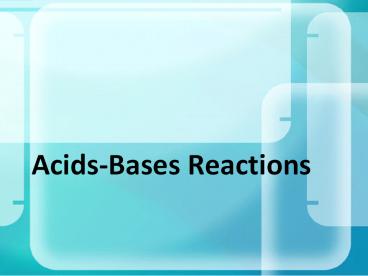Acids-Bases Reactions - PowerPoint PPT Presentation
1 / 22
Title:
Acids-Bases Reactions
Description:
Acids-Bases Reactions Acids & Bases What causes acid rain? And how can we prevent the damage? Why do Perrier drinking chickens give better eggs than chickens who ... – PowerPoint PPT presentation
Number of Views:285
Avg rating:3.0/5.0
Title: Acids-Bases Reactions
1
- Acids-Bases Reactions
2
Acids Bases
- What causes acid rain? And how can we prevent the
damage? - Why do Perrier drinking chickens give better eggs
than chickens who drink regular water? - These are the types of questions we will be able
to answer after this unit.
3
First Proposed Theory
- Arrhenius Theory of Acids Bases
- An acid is any substance which releases H(aq) in
water - - it is any ionic species that start with H
- - it tastes sour, turns blue litmus paper red
- eg. HCl, HNO3, H2SO4
- A base is any substance which releases OH-(aq) in
water - - it is any ionic species that ends with OH
- - it tastes bitter, feels slippery, turns red
litmus paper blue - eg. NaOH, KOH, Ca(OH)2
4
- A sAlt results from the neutralization rxn. of an
acid base - Neutralization rxn
- Acid Base ? salt H2O
- Net Ionic Equation
- H OH- ? H2O
- Eg. HCl(aq) NaOH(aq) ? NaCl(aq) H2O(l)
5
Q Predict the products balance the following
Neutralization Reactions
- H2SO4(aq) NaOH(aq) ?
- H2SO4(aq) 2 NaOH(aq) ? Na2SO4(aq) 2
H2O(l) - H3PO4(aq) KOH(aq) ?
- H3PO4(aq) 3 KOH(aq) ? K3PO4(aq) 3 H2O(l)
- H4P2O7(aq) NaOH(aq) ?
- H4P2O7(aq) 4 NaOH(aq) ? Na4P2O7(aq) 4
H2O(l)
6
Second Proposed Theory
- Bronsted-Lowry Theory of Acids Bases
- more general includes equilibrium rxns
- An acid is a substance that DONATES a PROTON (H)
- An base is a substance that Accepts a PROTON (H)
- Eg. NH3 H2O ? NH4 OH-
- NH3 gained a proton ? NH4
- Thus, NH3 BASE
- H2O lost a proton ? OH-
- Thus, H2O ACID
7
Your Turn!
- CH3COOH H2O ? CH3COO- H3O
- (lost/donated H) (gained H)
- ACID BASE
- Which reactants acts as an acid which as a
base? - HNO3 H2O ? NO3- H3O
- HCO3- SO32- ? CO32- HSO3-
- HS- H2PO4- ? H2S HPO42-
- H3PO4 CH3COO- ? H2PO4- CH3COOH
- CO32- HF ? HCO3- F-
8
Classifying Acids
- A monoprotic acid can donate 1 proton.
- A DIprotic acid can donate up to 2 proton.
- A triprotic acid can donate up to 3 proton.
- All acids that can donate more than 1 proton are
known as polyprotic acids.
9
Amphiprotic Substances
- Amphiprotic substances can act as an acid or a
base. - eg. Water
- NH3 H2O ? NH4 OH-
- Base acid
- CH3COOH H2O ? CH3COO- H3O
- Acid base
10
- Apart from water, amphiprotic substances start
with H and have a (?) charge. - eg. H2PO4- , HS-, HCO3-
- Base acid
- H3PO4 ? H2PO4- ? HPO42-
- Accepts H Donates H
11
- NOTE In every Bronsted-Lowry rxn. there is an
acid and a base on both sides of the eqn. - CH3COOH H2O ? CH3COO- H3O
- acid base base
acid
12
Q Which do you think exhibit amphiprotic
behavior?
- Se2-
- HSe-
- H2Se
- H3PO4
- HPO42-
- HSO3-
13
Q Identify each species as an acid or base.
- HF SO32- ? F- HSO3-
- H2O HCO3- ? H3O CO32-
- NO2- H2O ? OH- HNO2
- H2PO- S2- ? HS- HPO42-
- N2H5 SO42- ? N2H4 HSO4-
14
Conjugate Acid Bases
- A conjugate acid-base pair is a pair of
chemical species that only differ by ONE proton. - Eg. NH4 H2O ? NH3 H3O
- Acid has the extra proton (ability to donate
it)
Conjugate Pair Conjugate Acid Conjugate Base
NH4 , NH3 NH4 NH3
H2O, H3O H3O H2O
15
Assignment
- Acid Base Handout
- ? Questions 1 ? 4
16
Buffer Solutions
- Buffers are solutions with the ability to resist
the addition of strong acids or strong bases,
within limits. - eg. CH3COOH and its salt NaCH3COO
- Most buffer solutions are made up using a WEAK
ACID and its sodium salt!
17
When a strong base such as NaOH is added to the
buffer CH3COOH
- CH3COOH reacts with and consumes the excess OH-
- OH- reacts with the H3O ion from the acid in
the following reaction - H2O CH3COOH lt---gt H3O CH3COO-
- H3O OH- lt--------gt H2O
18
When a strong acid such as HCl is added to the
buffer CH3COOH
- H3O reacts with the CH3COOH- ions of the salt
and form more undissociated CH3COOH - H3O CH3COO- lt-------gt H2O CH3COOH
- There is a limit to the quantity of H or OH-
that a buffer can absorb without undergoing a
significant change in pH.
19
Buffer Components
- A buffer has two components.
- HA NaA ---gt Na A-
- (weak acid) (a soluble salt of the weak
acid) - Therefore any extra H3O will be neutralized by
the A- in the buffer - H3O A- lt-------gt HA H2O
- And any extra OH- that is added will be
neutralized by the acid - HA OH- lt------gt A- H2O
20
Sample Problem
- CH3COOH H2O ? CH3COO? H3O
- 1.0 M 1.0M
- Original Ratio Acid 1.0 1.0
- Base 1.0
- New Ratio 1.1 1.22
- 0.9
Add 0.1 mol H3O
ACID
1.1
BASE
0.9
21
Using Ka
- Original
- H3O (1.8 x 10-5)(1.0)
- 1.8 x 10-5
- pH 4.74
- After
- H3O (1.8 x 10-5)(1.22)
- 2.5 x 10-5
- pH 4.66
- pH change of 0.08
22
With no buffer present
- Adding 0.1 mol of acid to H2O would change the pH
by 6.00! - pH water 7
- pH water with 0.1M H3O 1
- Thus a difference of 6.































